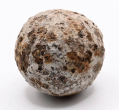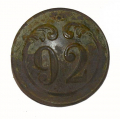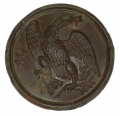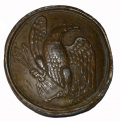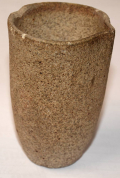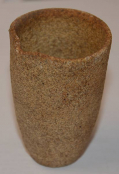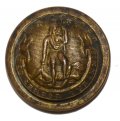site search
online catalog
Relics
Showing 201 to 220 out of 334
CANISTER BALL RECOVERED FROM THE NAPOLEONIC WAR BATTLEFIELD OF HANAU -1813
Dug lead canister ball meas. approx. 1.00 inch in diameter and in good relic condition. Item was dug on the Hanau battlefield by a resident of Carlisle, Pennsylvania while serving in Germany with the… (1202-40). Learn More »
DUG PATTERN 1854 AUSTRIAN BAYONET FROM FREDERICKSBURG
Bayonet has full length blade and socket with mortise. Locking ring is frozen. No markings are visible. Surfaces are rusted but have been coated with clear lacquer. Item was recovered at… (2023-1486). Learn More »
DUG PATTERN 1855 SOCKET BAYONET FROM FREDERICKSBURG
Bayonet has full length blade and socket with mortise. Locking ring is frozen. No markings are visible. Surfaces are rusted but have been coated with black paint. Blade has a slight bend to it. Item… (2023-1487). Learn More »
BUTTONS RECOVERED FROM BATTLE OF WÖRTH, 1870 - 78TH AND 92ND FRENCH REGIMENTAL
The Battle of Wörth, also known as the Battle of Reichshoffen or as the Battle of Frœschwiller, refers to the second battle of Wörth, which took place on 6 August 1870 in the opening stages of… (1202-). Learn More »
FRENCH CHASSEPOT BAYONET DUG ON THE FRANCO-PRUSSIAN WAR BATTLEFIELD OF WORTH FOUGHT IN AUGUST OF 1870
Item is a French Chassepot bayonet in good relic condition. Overall, the bayonet meas. approx. 27.00 inches long. The rusted blade looks to be near its full length and meas. 21.75 inches. Blade does… (1202-49). Learn More »
FRANCO-PRUSSIAN WAR NCO SWORD DUG ON THE 1870 BATTLEFIELD OF WORTH – UNIT MARKED
Item is a Prussian NCO sword in good relic condition. Overall the sword meas. approx. 22.50 inches. The rusted blade is full length and meas. 17.50 inches. Blade does exhibit some minor loss along the… (1202-48). Learn More »
LEAD SABOT FROM A KRUPP SHELL DUG ON THE BATTLEFIELD OF WORTH – AUGUST 1870
Folded piece of lead sabot meas. approx. 2.25 x 4.00 inches with three visible driving bands. Item was recovered on the August 6, 1870 battlefield of Worth. The Battle of Wörth, also known as the… (1202-59). Learn More »
RUSSIAN FORT ROSS (CALIFORNIA) DISPLAY
Presented in a 9” x 6” wood display case is a round ball and a Russian-Siberian coin with labels. The .54 caliber lead rifle ball was recovered at the site of Fort Ross. This was a Russian fur… (236-794). Learn More »
SMITH MARKED ROUND EAGLE CARTRIDGE BOX SHOULDER BELT PLATE FROM MYERS HILL, SPOTSYLVANIA, EX-KERKSIS
This regulation belt plate for the cartridge box sling came from the collection of Syd Kerksis, well-known and respected early collector and author, and still has his annotated envelope indicating he… (490-5858). Learn More »
RELIC PATTERN 1826 EAGLE BREAST PLATE FOR MODEL 1840 NCO BALDRIC RECOVERED AT STONES RIVER
This Pattern 1826 eagle breast plate is meant for use on the baldric of the Model 1840 NCO sword. The face of the plate is in very nice condition showing only minor wear from age and use. The right… (490-5759). Learn More »
U.S. M1839 CARTRIDGE BOX PLATE RECOVERED BY SYD KERKSIS IN JANUARY 1958 IN THE LINES OF THE 4th CORPS AT PICKETT’S MILL: ATLANTA CAMPAIGN
This plate comes with its original collection envelope with notations on its provenance by Syd Kerksis, noted early collector and author. Pickett’s Mill was fought on May 27, 1864, in the Atlanta… (490-5779). Learn More »
CARTRIDGE BOX PLATE FROM TUNNEL HILL, GA, EX-SYD KERKSIS
This regulation US cartridge box plate was recovered on the battlefield of “Tunnel Hill, Ga,” by Syd Kerksis, one of the legendary early relic hunters and collectors, author of books on military… (490-5771). Learn More »
DUG PATTERN 1855 BAYONET FROM FREDERICKSBURG
Bayonet has full length blade and socket with mortise. Locking ring is frozen. No markings are visible. Surfaces are covered in a heavy rust with remains of black paint. It appears that once the… (2022-1319). Learn More »
MODEL 1855/61 GUN TOOL ONCE OWNED BY J. HOWARD WERT
Recovered at Gettysburg, this is a complete Model 1855/61 gun tool. It is heavily rusted and the screwdriver tip is rusted tight. At the time of the Gettysburg campaign, twenty-two year-old John… (224-798). Learn More »
MID 19th CENTURY CRUCIBLE ONCE OWNED BY J. HOWARD WERT
One of many articles amassed by Wert after the Battle of Gettysburg. A crucible is also a container in which metals are melted, usually for temperatures above 500 °C. Crucibles are made of graphite… (224-794). Learn More »
MID 19th CENTURY CRUCIBLE ONCE OWNED BY J. HOWARD WERT
One of many articles amassed by Wert after the Battle of Gettysburg. A crucible is also a container in which metals are melted, usually for temperatures above 500 °C. Crucibles are made of graphite… (224-793). Learn More »
SCARCE CIVIL WAR ISSUE SHOE ALTERED TO CAMP/BARRACKS SHOE
The army did not issue “post,” “barracks,” or “camp” shoes until the 1880s. Before that it was up to soldiers to privately purchase or improvise footwear that might prove more comfortable… (1052-426). Learn More »
U.S. ARMY MODEL 1892 CURB BIT ONCE OWNED BY J. HOWARD WERT
This piece of US horse equipment is an original U.S. Army curb bit of the 1892 First Pattern, (a.k.a. the Whipple Bit) and was once owned by Gettysburg native J. Howard Wert. In strong condition, this… (224-790). Learn More »
U.S. MODEL 1874 CAVALRY CURB BIT ONCE OWNED BY J. HOWARD WERT
This piece of original US horse equipment is an original U.S. cavalry curb bit of the 1874 pattern. In strong condition, this iron bridle bit has a hard pockmarked surface with moderated rust pitting.… (224-788). Learn More »
POST-WAR VIRGINIA STAFF OFFICER’S BUTTON BY HORSTMANN
This three-piece coat size Virginia button has substantial gilt left on the face and good detailing of the figures of the Virginia state seal and the motto on a ribbon on a lined background with an… (1000-2250). Learn More »
$115.00
Originally $145.00
Showing 201 to 220 out of 334
Most Popular
Historical Firearms Stolen From The National Civil War Museum In Harrisburg, Pa »
Theft From Gravesite Of Gen. John Reynolds »
Selection Of Unframed Prints By Don Troiani »
Fine Condition Brass Infantry Bugle Insignia »
Large English Bowie Knife With Sheath 1870’S – 1880’S »
Imported (Clauberg) Us Model 1860 Light Cavalry Officer's Saber »
featured item
RARE PACK OF CONFEDERATE, RICHMOND ARSENAL, ARTILLERY FRICTION PRIMERS
Offered here is a very rare, nice condition, original pack of artillery friction primers manufactured at the Richmond Arsenal in Virginia during the Civil War. These “primers” are what was placed in the cannon vent hole and attached to a lanyard… (1268-512). Learn More »



